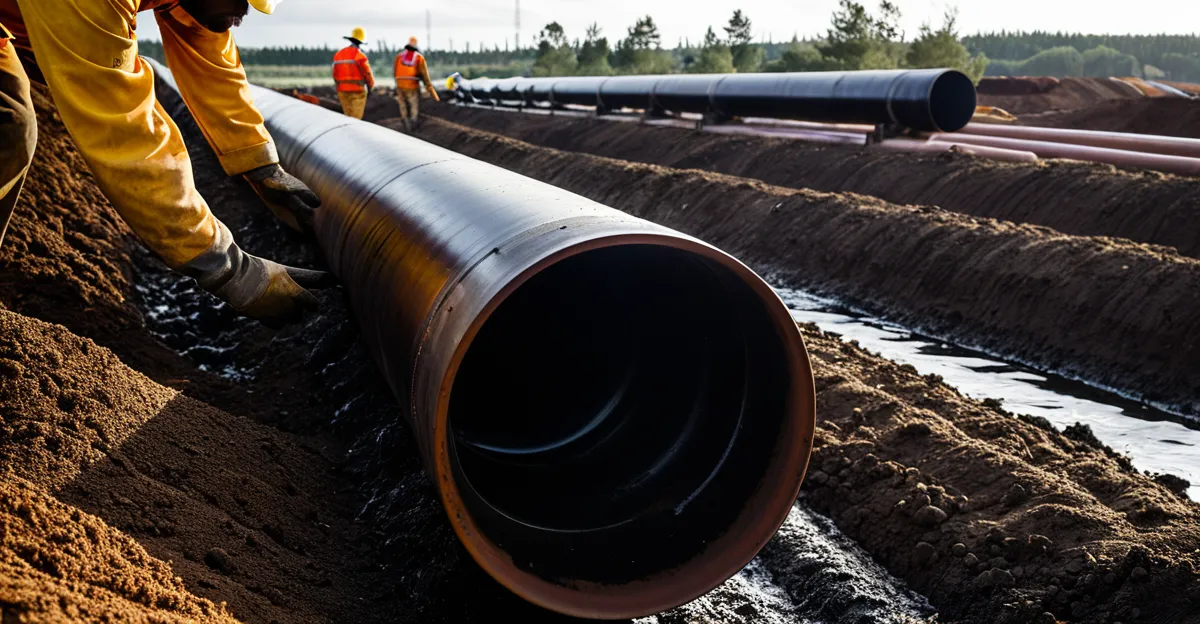Selecting the right micropile oil pipeline tube directly influences your project’s durability and safety. Understanding material properties, dimensions, and fabrication techniques ensures optimal foundation support and pipeline integrity. Tailored solutions withstand challenging environments—from urban sites to remote fields—delivering strength without compromise. This guidance will help you pinpoint steel pipe options that match structural demands and project timelines with precision.
Technical Overview and Key Options for Micropile Oil Pipeline Tube Selection
Understanding how to select a micropile oil pipeline tube for your project starts with a clear grasp of available specifications and standards. In 2025, engineers can expect tubes designed to suit a wide spectrum of load demands, custom site limitations, and evolving safety requirements. Common tube diameters range from as small as 5 mm up to several thousand millimeters, enhanced by precise wall thicknesses for target load capacities. Material selection remains pivotal: S235, S275, and S355 steel grades are frequently chosen, each certified under EN 10219 or ASTM guidelines.
Also to read : What Are the Best Practices for Enhancing Cybersecurity in UK Government Agencies?
Key options include seamless, welded, and splice-to-length pipes, offering adaptability for confined or open environments and various installation methods. Micropile installation often leverages rotary or electric drilling with simultaneous grouting, providing robust soil adhesion regardless of site geology. For aggressive environments or corrosive soils, specialized coatings and internal/external protection ensure long-term pipeline durability.
It’s useful to compare casing materials—new, surplus, or certified secondary pipe—against project needs for corrosion resistance and certification. Each selection should align with site-specific factors like seismic demands, clearance constraints, and the desired load-bearing profile. Proper material and design choices optimize both structural performance and life-cycle value.
In the same genre : How Can UK Financial Advisors Use Data Analytics to Offer Better Services?
Understanding Micropiles and Pipeline Tubes: Definitions, Properties, and Uses
Fundamental definitions of micropiles and pipeline tubes
Micropiles are high-strength, small diameter piles—typically 12 inches or less—that serve as vital elements in deep foundation support. Their defining feature lies in their ability to be installed via a variety of micropile installation techniques, including drilling, grouting, and injection methods, making them exceptionally versatile for a range of ground conditions. Pipeline tubes, on the other hand, are manufactured steel pipes designed for conduiting fluids, especially oils, in energy and infrastructure projects. Pipeline tube diameter options and selection directly impact flow capacity and pressure, influencing overall project efficiency.
Material types, dimensions, and structural properties
The majority of micropiles and pipeline tubes are fabricated from steel, often adhering to rigorous standards for pipeline casing materials like S235, S275, or S355 grades. Dimensional flexibility is critical; manufacturers offer a wide spectrum of pipeline tube diameter options, from small-bore types suitable for urban constraint to larger dimensions for high-capacity oil lines. The structural integrity of these components is determined by both material properties and the effectiveness of pipeline tube welding techniques, ensuring durability and compliance with pipeline safety standards.
Main usage scenarios: urban construction, foundation support, oil and gas reinforcement
Micropile installation techniques enable their use in urban construction, where restricted access and low headroom challenge traditional piling systems. In deep foundation projects, micropiles deliver reliable support on varied soil types, facilitated by advances in soil stabilization methods and grouting technology. For oil and gas pipeline reinforcement, engineers rely on an informed mix of pipeline casing materials and precise pipeline tube diameter options to optimize load capacity and minimize risks from corrosion or ground movement, ensuring robust, long-lasting infrastructure.
Critical Technical Specifications and Engineering Standards
Pipe and Tube Size Ranges, Wall Thicknesses, and Diameter Options
Selecting pipeline casing materials involves precise attention to pipeline tube diameter options and wall thickness. For micropile foundations, supply options range from 5 mm up to approximately 305 mm in diameter, with custom wall thicknesses adapted for site-specific micropile installation techniques and geotechnical conditions. Adjusting pipeline tube diameter options supports requirements for micropile load capacity and oil pipeline construction methods, directly impacting soil stabilization methods and pipeline tube durability testing. Engineers consider these values carefully, knowing that dimensional flexibility can optimize underground pipeline protection and seismic resistance of micropiles.
Overview of Material Standards and Certification Requirements
Pipeline tube materials comparison starts with adherence to robust standards: EN 10219 prescribes requirements for hollow steel sections, often in grades S235, S275, or S355. These steel grades meet or exceed safety and pipeline safety standards demanded by oil pipeline regulatory compliance. Certification, typically according to EN 10204, demonstrates complete quality assurance—a necessity for pipeline tube strength testing, pipeline tube inspection techniques, and reliable micropile installation monitoring.
Comparison of Steel Grades and Coating Systems
Pipeline casing materials must withstand harsh environments. Grades S235, S275, and S355 offer increasing strength and resilience, ensuring pipeline corrosion resistance and long service in micropile applications. Engineers reference pipeline tube materials comparison for coating system selection—external and internal coatings, along with corrosion prevention coatings, extend life and protect against soil and environmental impacts. This careful pairing of steel grade and coating, supported by pipeline tube durability testing, ensures foundation reliability for both micropile and oil pipeline solutions.
Micropile and Oil Pipeline Tube Installation Techniques
Proven Installation Methods: Drilling, Grouting, Splicing, and Welding
Micropile installation techniques begin with drilling and grouting methods that adapt to tight or low-clearance sites. Rotary and electric rigs enable precise borehole creation, often using simultaneous cement and rebar injection. This establishes strong micropile soil bonding and accelerates the overall process. Next, reinforcement such as steel bars is inserted, followed by grout injection using vibration equipment to improve compaction and ensure robust micropile load capacity. Key connection points utilize splicing and welding. Advanced pipeline tube welding techniques increase durability and structural continuity, critical for both oil pipeline construction methods and foundation projects.
Equipment and Machinery Used in Installation
Installation relies on versatile tube pile installation equipment: rotary rigs, extrusion drills, and hydraulic grouting machines. Machinery selection depends on soil types suitable for micropiles and site constraints, whether urban foundations or remote locations. Customizable pipeline tube diameter options allow fitment in diverse geotechnical scenarios. Where pipeline construction is necessary, machinery also accommodates seamless pipeline tube material innovation, such as pipes with internal coatings and enhanced diameter tolerances.
Load Testing and Quality Control Procedures
During and after installation, micropile load testing procedures are essential for verifying designed micropile load capacity. Quality assurance utilizes pipeline tube quality control measures—dimensional checks, weld integrity testing, and grouting pressure monitoring. These steps confirm that drilling and grouting methods have achieved desired performance. Additionally, adherence to pipeline safety standards ensures every phase meets regulatory and structural expectations.
Performance Factors: Load Capacity, Corrosion Resistance, and Maintenance
Determining and Optimizing Micropile and Pipeline Load Capacity
The Stanford Question Answering Dataset (SQuAD) method points to a fact-based approach: micropile load capacity hinges on pile size, soil conditions, reinforcement, and installation technique. For oil pipelines, engineers evaluate pipeline tube strength through pipeline tube strength testing and consistent quality controls. Maximizing micropile load capacity requires the right mix of reinforcement material and precision in micropile load testing procedures. Adjustments to steel grades, tube diameter, and wall thickness further fine-tune the micropile load capacity for specific applications.
Corrosion Resistance Options: Coatings, Inhibitors, Material Selection
Protecting pipelines from corrosion is critical for longevity. Employing advanced pipeline corrosion resistance methods—such as internal and external corrosion prevention coatings—significantly extends pipeline life. The strategic use of corrosion inhibitors and careful material selection, including certified steel grades and seamless splicing, strengthens pipeline tube corrosion resistance. Quality coating application and regular pipeline tube corrosion testing underpin robust defenses.
Maintenance Strategies for Long-Term Integrity
Effective oil pipeline maintenance strategies pair regular inspection with predictive monitoring. Employing advanced pipeline integrity management programs, using modern inspection tools, and following rigorous pipeline tube inspection techniques are essential for mitigating risks. Proactive maintenance, including swift repair solutions and ongoing monitoring, ensures both pipeline and foundation systems maintain their performance, minimizing unforeseen downtime and optimizing asset life cycles.
Application Examples and Project Case Studies
Real-world uses in challenging soils, seismic regions, and confined urban sites
Micropile application in harsh soils addresses some of construction’s most persistent problems. In settings where traditional foundation methods struggle—such as clayey, saturated, or rocky ground—special micropile installation techniques can deliver reliable support. These techniques typically involve sophisticated drilling and grouting methods tailored to high water tables or confined access areas, ensuring minimal disturbance and rapid deployment. Soil stabilization methods, particularly when combined with precision pipe solutions, offer notable gains in performance and adaptability, even under urban limitations.
Notable engineering projects in infrastructure and oil/gas sectors
Pipeline laying best practices have evolved through the successful implementation of micropile application in harsh soils. For example, deep foundation upgrades in metropolitan transit stations and bridge supports along rivers frequently utilize specialized soil stabilization methods to reduce settlement risks. In oil and gas, pipeline casing materials and corrosion prevention coatings are carefully selected for aggressive ground conditions. These solutions are underpinned by rigorous pipeline tube strength testing and pipeline tube welding techniques, upholding the structural integrity necessary for safe hydrocarbon transport.
Lessons learned and best practices from past installations
A key takeaway from multiple micropile project case studies is that integrating soil stabilization methods with advanced pipeline laying best practices significantly boosts both lifespan and reliability. Continuous refinement of micropile application in harsh soils—such as real-time load testing and grouting pressure monitoring—has shown measurable improvements in load distribution and seismic resistance. These experiences underscore the value of adaptive strategies in foundation design and underground pipeline protection.
Supplier Selection, Customization, and Purchasing Considerations
Leading suppliers: technical capabilities, certification, and service differentiation
Top suppliers distinguish themselves by advanced pipeline tube manufacturing process expertise and thorough pipeline tube materials comparison, supporting wide oil pipeline project planning needs. Many supply seamless and welded tubes meeting EN 10219 standards with steel grades like S235 and S355. Vendors often hold third-party certifications and detailed inspection reports, providing confidence in the pipeline tube manufacturing process. Their technical strengths enable them to address engineering standards required for safety, seismic resistance, and environmental impact.
Options for pipe and tube customization
Customization is a pivotal factor in oil pipeline project planning. Leading vendors allow clients to select from a full spectrum of pipeline tube materials comparison options, varying lengths, wall thicknesses, and coatings. The pipeline tube manufacturing process typically enables custom threading (male/female), welded or spliced joints, and surface or internal pipeline tube coating applications for corrosion and abrasion resistance. Clients may request custom profiling, retractable valves, or integrated coupling systems, optimizing fit for site-specific conditions or regulatory needs.
Key factors in procurement: lead times, quality control, and delivery
Effective procurement extends beyond material selection. Considerations include supplier lead times, comprehensive pipeline tube quality control with traceable certification, and logistical capacity for global delivery. The ability to provide detailed documentation regarding the pipeline tube manufacturing process, offer robust after-sales support, and coordinate with project schedules becomes vital in oil pipeline project planning. Attention to these aspects not only streamlines installation but also reduces risk during each project phase.












